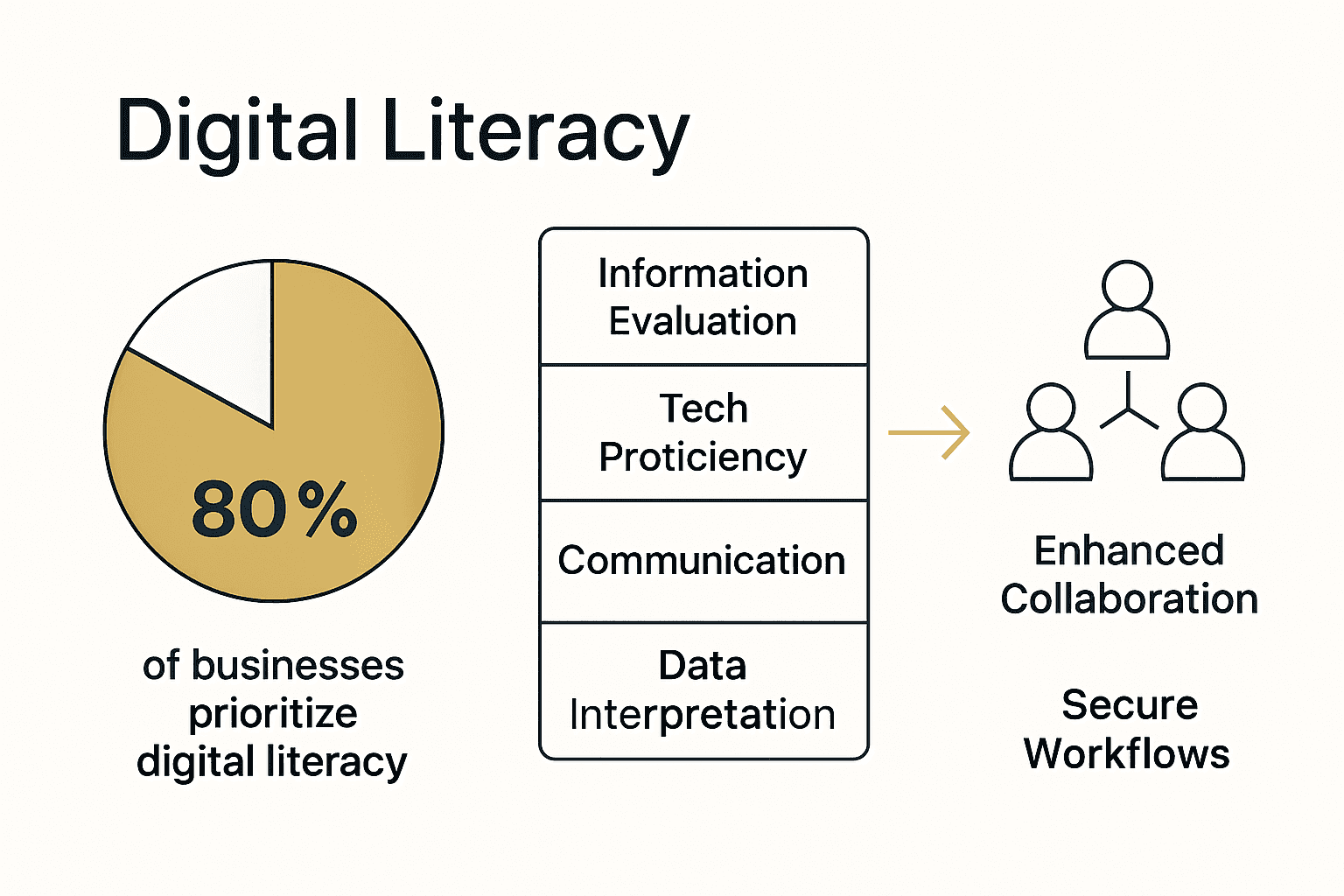Did you know that over 80 percent of businesses now list digital literacy among their top hiring criteria? Technology keeps advancing at a rapid pace, forcing organizations to rethink the way they operate and collaborate. Leaders and teams who master digital tools, clear communication, and data analysis do more than keep up with change—they drive it. Understanding what digital literacy means for business opens the door to stronger decision-making, smoother workflows, and workforce resilience.
Table of Contents
- Defining Digital Literacy Essentials For Businesses
- Types Of Digital Literacy Skills In The Workplace
- Integrating Digital Literacy Into Document Workflows
- Security, Compliance, And Risk Management Considerations
- Best Practices For Building Digital Literacy Culture
Key Takeaways
| Point | Details |
|---|---|
| Digital Literacy is Essential | Businesses must prioritize digital literacy as a critical competency for success in today’s tech-driven landscape. |
| Continuous Learning is Key | Organizations should invest in ongoing training and skills development to adapt to evolving digital technologies. |
| Integrating Digital Literacy in Workflows | Incorporating digital literacy into document management and workflows enhances efficiency and decision-making. |
| Fostering a Digital Culture | Building a digital literacy culture requires leadership commitment and an environment that encourages experimentation and innovation. |
Defining Digital Literacy Essentials for Businesses
In today’s rapidly evolving technological landscape, digital literacy has become more than just a skill set – it’s a critical organizational competency. According to research from Indeed, digital literacy in business fundamentally refers to the ability to critically locate, evaluate, interpret, and use digital information and communication tools effectively within workplace contexts.
Digital literacy encompasses several core capabilities that modern enterprises must develop:
Here’s a summary of the core digital literacy skills essential for modern businesses:
| Skill Area | Description | Key Outcomes |
|---|---|---|
| Information Evaluation | Assess digital source credibility | Reliable decision-making |
| Technology Proficiency | Use digital tools effectively | Smoother tech adoption |
| Communication Skills | Navigate digital channels professionally | Strong collaboration |
| Data Interpretation | Transform data into insights | Informed strategies |
- Information Evaluation: Critically assessing the credibility and reliability of digital sources
- Technology Proficiency: Understanding and effectively using various digital tools and platforms
- Communication Skills: Navigating digital communication channels with precision and professional awareness
- Data Interpretation: Analyzing and transforming digital information into actionable insights
Businesses that prioritize digital literacy see tangible benefits across multiple operational domains. Adapting to new technologies becomes smoother, employee collaboration improves, and overall organizational adaptability increases. Professionals who demonstrate strong digital literacy contribute more effectively to their teams, supporting both individual career development and broader organizational objectives.
Ultimately, digital literacy is no longer optional – it’s a fundamental requirement for sustainable business success in the digital age.
 Organizations must invest in continuous learning, provide robust digital skills training, and create environments that encourage technological fluency and adaptive thinking.
Organizations must invest in continuous learning, provide robust digital skills training, and create environments that encourage technological fluency and adaptive thinking.
Types of Digital Literacy Skills in the Workplace
In the modern professional environment, digital literacy extends far beyond basic computer skills. Workplace digital literacy now encompasses a sophisticated range of competencies that enable employees to effectively navigate, utilize, and leverage digital technologies across various professional contexts.
Key types of digital literacy skills include:
- Technological Adaptation Skills: Ability to quickly learn and integrate new digital tools and platforms
- Cybersecurity Awareness: Understanding digital security protocols, recognizing potential digital threats, and practicing safe online behaviors
- Collaborative Digital Communication: Proficiency in using digital collaboration platforms, video conferencing tools, and virtual communication channels
- Data Management and Analysis: Capability to collect, interpret, visualize, and derive insights from complex digital information
- Digital Content Creation: Skills in developing digital content using various software and multimedia tools
Digital transformation strategies play a crucial role in developing these skills. Organizations must recognize that digital literacy is not a static skill set but a dynamic competency requiring continuous learning and adaptation. Employees who master these skills become valuable assets, capable of driving innovation and efficiency across different business functions.
Successful digital literacy development involves strategic training programs, ongoing skill assessments, and creating a workplace culture that encourages technological curiosity and continuous professional development. By investing in comprehensive digital literacy initiatives, businesses can create more agile, responsive, and technologically empowered workforce ecosystems.
Integrating Digital Literacy Into Document Workflows
Digital literacy has become a critical component of modern document management strategies, transforming how businesses handle, process, and communicate information. According to research from arXiv, new AI-augmented workspace tools are supporting sensemaking across business document collections by reducing cognitive load and enabling more accurate decision-making.
Key strategies for integrating digital literacy into document workflows include:
- Automated Document Processing: Implementing intelligent systems that can automatically categorize, route, and analyze digital documents
- Collaborative Digital Platforms: Leveraging cloud-based tools that enable real-time document collaboration and version control
- Security and Compliance Training: Developing comprehensive programs that teach employees about digital document protection and regulatory requirements
- Advanced Search and Retrieval Skills: Training staff to efficiently locate, extract, and utilize information from complex digital document repositories
Understanding digital document transformation plays a crucial role in this integration. As research from Xerox DocuShare demonstrates, enterprise document management systems now support workflow automation by securely managing, storing, and sharing digital content across departments. This approach not only improves efficiency but also creates a more adaptive and responsive organizational ecosystem.

Successful integration requires a holistic approach that combines technological infrastructure, continuous employee training, and a cultural shift towards digital-first document management. Organizations must invest in both technological tools and human skills development, creating an environment where digital literacy becomes an inherent part of daily document workflows rather than an additional burden.
Security, Compliance, and Risk Management Considerations
Digital security has transformed from a technical requirement to a critical business strategy in the modern enterprise landscape. According to research from TechTarget, digital literacy now encompasses comprehensive awareness of cybersecurity threats, including understanding complex issues like phishing, data privacy concerns, and safe usage of advanced digital platforms.
Key considerations for robust digital security include:
- Threat Awareness: Developing organizational capabilities to recognize and respond to evolving digital security risks
- Regulatory Compliance: Implementing frameworks that align with data protection regulations like GDPR and CCPA
- Proactive Risk Management: Creating adaptive monitoring systems that anticipate and mitigate potential digital vulnerabilities
- Employee Training: Establishing continuous education programs that enhance digital security consciousness
Understanding the importance of document security becomes crucial in this context. Research from arXiv suggests that enterprises require sophisticated digital forensics strategies that combine comprehensive security frameworks with adaptive monitoring techniques. These approaches enable organizations to create resilient digital environments that protect sensitive information while maintaining operational flexibility.
Successful security and compliance management demands a holistic approach that integrates technological solutions, strategic planning, and continuous workforce education. Organizations must view digital security not as a static set of rules, but as a dynamic, evolving ecosystem that requires ongoing attention, investment, and cultural commitment.
Best Practices for Building Digital Literacy Culture
Digital culture is more than a technology implementation strategy – it’s a fundamental reimagining of how organizations operate and evolve. According to research from HR experts, building a robust digital literacy culture requires strategic alignment of organizational practices with technological goals and a commitment to continuous learning and adaptation.
Key best practices for cultivating a digital literacy culture include:
- Leadership Commitment: Demonstrating visible support and personal engagement with digital transformation initiatives
- Continuous Learning Pathways: Creating structured upskilling programs that support ongoing digital skill development
- Psychological Safety: Fostering an environment where employees feel comfortable experimenting with new digital tools and methodologies
- Data-Driven Decision Making: Encouraging evidence-based approaches that leverage digital insights and analytics
- Innovation Rewards: Recognizing and celebrating employees who demonstrate exceptional digital adaptability
Balancing security and usability becomes critical in this transformation process. Research indicates that successful digital cultures understand the interconnectedness of digital tools and promote habits that support seamless technological integration. Organizations must move beyond traditional training models to create immersive learning experiences that make digital literacy feel natural and intuitive.
Ultimately, building a digital literacy culture is an ongoing journey that requires persistent effort, strategic investment, and a willingness to embrace continuous change. Successful organizations will treat digital literacy not as a destination, but as a dynamic, evolving ecosystem of learning, innovation, and adaptive capability.
Empower Your Enterprise With Essential Digital Literacy and Advanced Document Solutions
Digital literacy is no longer just a skill but a vital factor in adapting to rapid technological change and securing your company’s future. The challenges of evaluating information, mastering new digital tools, and ensuring secure document workflows demand solutions that support efficiency and confidence. If your business aims to enhance collaboration, automate complex PDF processes, or strengthen security compliance, this is the moment to act.

Explore how Mapsoft’s specialized Adobe Acrobat® plug-ins and web-based services can simplify your document management while boosting digital literacy across teams. Our offerings are designed to help businesses like yours streamline workflows, automate PDF handling, and ensure secure digital preservation. Dive deeper into the power of Digital Preservation to protect your critical documents and unlock full digital potential. Discover tailored solutions that align perfectly with your enterprise needs at Mapsoft.com and explore more about our comprehensive offerings on our Uncategorized page.
Take the next step to empower your workforce and future-proof your business. Visit Mapsoft today and start transforming digital literacy into a competitive advantage.
Frequently Asked Questions
What are the core digital literacy skills essential for modern businesses?
Digital literacy skills essential for businesses include information evaluation, technology proficiency, communication skills, and data interpretation. These skills enable employees to effectively use digital tools and make informed decisions.
How can organizations integrate digital literacy into their document workflows?
Organizations can integrate digital literacy into document workflows by implementing automated document processing, using collaborative digital platforms for real-time editing, providing security and compliance training, and developing advanced search and retrieval skills.
Why is cybersecurity awareness important in digital literacy?
Cybersecurity awareness is crucial as it enables employees to recognize potential digital threats, understand data privacy issues, and practice safe online behaviors, thus minimizing the risk of security breaches.
What best practices should organizations follow to build a digital literacy culture?
Organizations should demonstrate leadership commitment, create continuous learning pathways, foster psychological safety for experimentation, promote data-driven decision-making, and recognize innovative efforts among employees to build a strong digital literacy culture.



